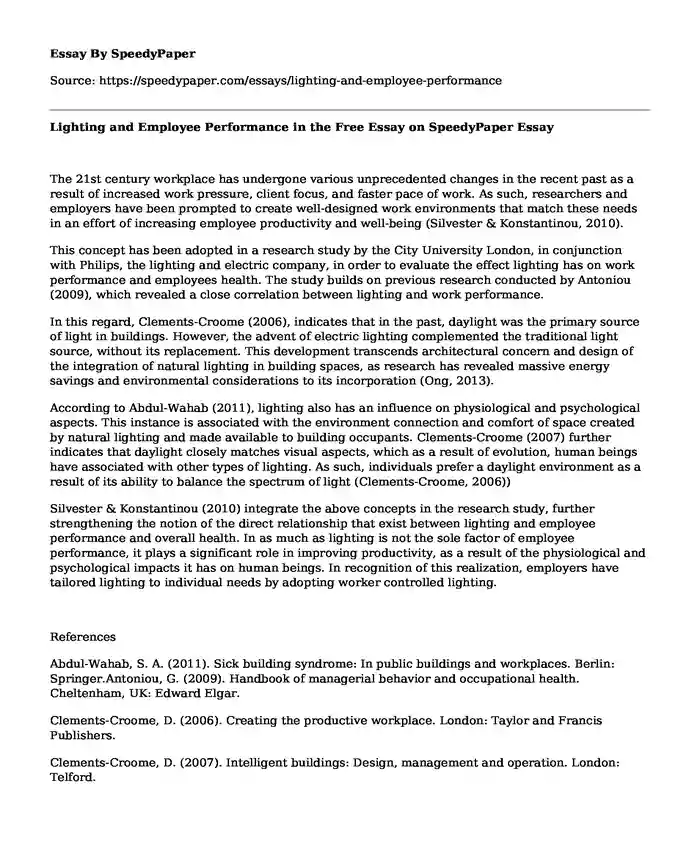
| Type of paper: | Essay |
| Categories: | Human resources Productivity Employment |
| Pages: | 2 |
| Wordcount: | 420 words |
The 21st century workplace has undergone various unprecedented changes in the recent past as a result of increased work pressure, client focus, and faster pace of work. As such, researchers and employers have been prompted to create well-designed work environments that match these needs in an effort of increasing employee productivity and well-being (Silvester & Konstantinou, 2010).
This concept has been adopted in a research study by the City University London, in conjunction with Philips, the lighting and electric company, in order to evaluate the effect lighting has on work performance and employees health. The study builds on previous research conducted by Antoniou (2009), which revealed a close correlation between lighting and work performance.
In this regard, Clements-Croome (2006), indicates that in the past, daylight was the primary source of light in buildings. However, the advent of electric lighting complemented the traditional light source, without its replacement. This development transcends architectural concern and design of the integration of natural lighting in building spaces, as research has revealed massive energy savings and environmental considerations to its incorporation (Ong, 2013).
According to Abdul-Wahab (2011), lighting also has an influence on physiological and psychological aspects. This instance is associated with the environment connection and comfort of space created by natural lighting and made available to building occupants. Clements-Croome (2007) further indicates that daylight closely matches visual aspects, which as a result of evolution, human beings have associated with other types of lighting. As such, individuals prefer a daylight environment as a result of its ability to balance the spectrum of light (Clements-Croome, 2006))
Silvester & Konstantinou (2010) integrate the above concepts in the research study, further strengthening the notion of the direct relationship that exist between lighting and employee performance and overall health. In as much as lighting is not the sole factor of employee performance, it plays a significant role in improving productivity, as a result of the physiological and psychological impacts it has on human beings. In recognition of this realization, employers have tailored lighting to individual needs by adopting worker controlled lighting.
References
Abdul-Wahab, S. A. (2011). Sick building syndrome: In public buildings and workplaces. Berlin: Springer.Antoniou, G. (2009). Handbook of managerial behavior and occupational health. Cheltenham, UK: Edward Elgar.
Clements-Croome, D. (2006). Creating the productive workplace. London: Taylor and Francis Publishers.
Clements-Croome, D. (2007). Intelligent buildings: Design, management and operation. London: Telford.
Ong, B. (2013). Beyond environmental comfort. New York: Routledge Publishers.
Silvester, J. & Konstantinou, E. (2010). Lighting, well-being and work performance. City University, London: Philips International. Retrieved from http://www.cassknowledge.com/sites/default/files/article-attachments/lighting-work-performance-cass.pdf
Cite this page
Lighting and Employee Performance in the Free Essay on SpeedyPaper. (2019, Nov 11). Retrieved from https://speedypaper.com/essays/lighting-and-employee-performance
Request Removal
If you are the original author of this essay and no longer wish to have it published on the SpeedyPaper website, please click below to request its removal:
- Free Essay on the Social and Business Networking Article
- Good Attitude towards Getting a Speeding Ticket - Personal Experience Essay Sample
- Twin Deficits: Does a Government Deficit Cause a Current Account Deficit? Essay Sample
- Free Essay about Leadership Styles: Democratic Leadership Style
- Essay Sample on Activity Deficit Hyperactivity Disorder
- Critical Essay on "Becoming": A Memoir by Mitchell Obama
- Essay Sample on the Marketing Challenges Facing Clocky
Popular categories




